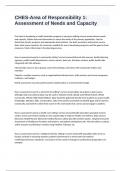CHES-Area of Responsibility 1:
Assessment of Needs and Capacity
First step in developing a health education program in any given setting correct answersAssess needs
and capacity. Gather data and information to assess the needs of the primary population. Used to
determine priority programs and appropriate interventions. Use both secondary and primary source
data. Must assess capacity: the resources available for use in developing programs and the gaps in those
resources. Most critical step in the planning process.
How is assessment used in a community setting? correct answersExternal data sources: health planning
agencies, public health departments, census reports, data sets, literature reviews, public health data
integrated with GIS software
Internal data sources: focus groups, town hall meetings, interviews with community leaders and
members
Capacity: consider resources such as organizational infrastructure, staff, previous and current programs,
readiness, and budget.
Needs assessment may also point towards needed policy or environmental change
How is assessment used in a school (k-12) setting? correct answersData: local data is main source,
although state and national data may be used to indicate trends. Ideally used Whole School, Whole
Community, Whole Child Model (WSCC). Data should be gathered directly from students to assess health
knowledge, attitudes, skills, and practices. Data from parents and admin to identify gaps and/or barriers.
Community assessment to determine assets in the community that can be used and gaps to address.
How is assessment used in a health care setting? correct answersHealth education specialists may be
used to assess and review existing or new reports/data to improve health care delivery. Data sources:
Electronic Health Record, Electronic Medical Record, safety data like incident reports, Hospital Consumer
Assessment of Healthcare Providers and Systems, and patient satisfaction tools. Must be able to conduct
online research and literature reviews using Medline, Pubmed, etc.
How is assessment used in a College/University setting? correct answersHE specialists often serve as
faculty, involved in assessing student academic performance to meet state and national
certification/licensure standards. Curriculum review could reveal gaps in professional preparation, for
example.
, How is assessment used in worksite/business settings? correct answersHE specialists may work with
healthcare professionals, specialty health and wellbeing vendors, and/or health insurance carriers OR
use their own data collection strategies to identify health needs of employees. Data may include: Health
risk assessments (HRAs), needs and interest surveys, health insurance claims, pharmacy data, predictive
modeling tools (future risk projections), disease prevalence, disability claims, and absenteeism. Analysis
would indicate priority needs for worksite programs
How is assessment used in College/University Health Promotion Services Settings? correct answersHE
specialists work with clinical practitioners and staff in counseling student life, human resources, and
fitness/wellness centers. Determine individual and community needs for students, faculty and staff using
data obtained by focus group, surveys, interviews, etc. Assessment process includes developing ways to
obtain info on the PP knowledge, skills, perceptions, attitudes, beliefs, learning preferences, and
perceived needs. Resources must be identified/obtained.
advisory committee correct answersusually consists of a group of individuals who are concerned about a
common issue and in a position to report on their actual experiences with it. Members of the advisory
committee can offer advice to one individual or another group of people making programmatic decisions
capacity assessment correct answersA measure of actual and potential individual, group, and community
resources that can be inherent to and/or brought to bear for health maintenance and enhancement. The
process of mapping community assets is included in the capacity assessment.
Coalition correct answersa group of diverse organizations and constituencies working together toward a
common goal
Qualitative Data correct answersdata in narrative form, which is collected to better understand
motivation, thoughts, feelings and behaviors
Quantitative Data correct answersdata collected in numerical form, or easily translated into numerical
form
Planning Committee correct answersadvisory committee members, experts, and agency staff. The
lifespand of this committee may be episodic (with limited duration) or continuing (on-going)




